GetStudySolution
Getstudysolution is an online educational platform that allows students to access quality educational services and study materials at no cost.
NCERT Solutions for Class 9 History chapter 1 – The French Revolution
Back Exercise
1. Describe the circumstances leading to the outbreak of revolutionary protest in France.
Answer:
• When King Louis XVI was anointed as the new king, he found an empty treasury.
• Long years of war had drained the financial resources of France. On top of this, there was the cost of maintaining an extravagant court at the immense palace of Versailles.
• France had helped the thirteen American colonies gain their independence from their common enemy, Britain. The war added more than a billion livres to a debt that had already risen to more than 2 billion livres.
• Lenders who gave credit began to charge 10 per cent interest on loans. So the French Government had to spend an increasing percentage of its budget on interest payments alone.
• To meet its regular expenses, such as cost of maintaining an army, the court, governmental offices and Universities was increasingly becoming difficult. Raising taxes did not suffice, because the French society was divided into 3 estates and only the 3rd estate had to pay taxes. The 1st estate and the 2nd estate did not pay any taxes.
• The population of France was also growing massively. This led to a rapid increase in the demand for food grains. Production of grains could not keep pace with demand. So the price of bread, which was the staple diet of the majority rose rapidly.
• Most workers were employed as labourers in workshops, whose owner fixed their wages. But the wages did not keep pace with the rise in prices. So the gap between the rich and the poor widened.
• All these factors led to the outbreak of the French Revolution.
2. Which groups of French society benefited from the revolution? Which groups were forced to relinquish power? Which sections of society would have been disappointed with the outcome of the revolution?
Answer:
French society was divided into 3 estates. The third estate benefitted the most. The third estate consisted of Peasants, artisans, Small peasants, landless labour, servants, big businessmen, merchants, court officials, lawyers etc. The groups that were forced to relinquish power were the people belonging to the 1st and 2nd estate. These people had enjoyed certain privileges by birth. With the revolution, the people in 1st and 2nd estate lost their privileges. Because inequality was one of the root causes of the revolution, the revolution tried to bring equality to the society.
3. Describe the legacy of the French Revolution for the peoples of the world during the nineteenth and twentieth centuries.
Answer:
The ideas of liberty and democratic rights are the most important legacies of the French revolution. These spread from France to the rest of Europe during the nineteenth century, where feudal systems were abolished. Colonised people reworked the idea of freedom from bondage into their movements to create a sovereign nation-state. Tipu Sultan and Ram Mohan Roy are two examples of individuals who responded to the ideas originating from Revolutionary France.
4. Draw up a list of democratic rights we enjoy today whose origins could be traced to the French Revolution.
Answer:
The list of democratic rights are
- Freedom of speech
- Freedom of expression
- Freedom of press
- Abolition of censorship
- Right to vote
- Abolition of slavery
- Right to liberty
- Right to property
- Right to security
- Right to education
- Divorce laws
5. Would you agree with the view that the message of universal rights was beset with contradictions? Explain.
Answer:
Though it says ‘Universal Rights’, women were unfortunately left out from the basic rights that were promised. They did not have equal rights that men enjoyed. They did not have the right to liberty, property, security and above all, the resistance to oppression. In the formulation of laws, women did not have any representation. Women were not entitled to all the honours and public employment, according to their abilities.
6. How would you explain the rise of Napoleon?
Answer:
Napoleon Bonaparte crowned himself Emperor of France. He started conquering neighbouring countries by waging wars against them. He saw himself as a moderniser of Europe. He introduced many laws such as the protection of private property and a uniform system of weights and measures provided by the decimal system. Many of his measures carried the revolutionary ideas of liberty and modern laws to the other parts of Europe. This had a positive impact on people long after he was dethroned as an emperor, when he was finally defeated in the Battle of Waterloo.
In-Text Questions
Page 5Activity 1. Explain why the artist has portrayed the nobleman as the spider and the peasant as the fly?
Answer The spider feeds on the fly, whereas the fly does hard labour for finding its food. Similarly, in 18th century, France, the nobles lived off the labour of the peasants. The social reality of the time was that peasants had to pay feudal dues as well as rendering services for the nobles.
Page 6
Activity 1. Fill in the blank boxes in Fig. 4 with appropriate terms from among the following: Food riots, scarcity of grain, increased number of deaths, rising food prices, weaker bodies.
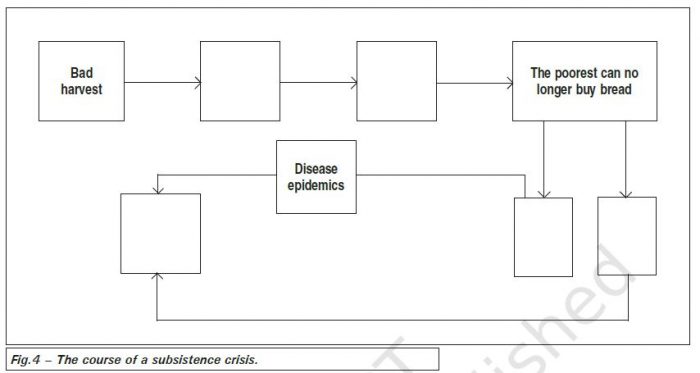
Answer

Page 7
Activity 1. What message is Young trying to convey here? Whom does he mean when he speaks of ‘slaves? Who is he criticising? What dangers does he sense in the situation of 1787?
Answer Young is conveying the message that any social system based on injustice will not last long and its consequences can be disastrous for the exploiters. The ‘slaves’ mentioned by him are the peasants, servants and landless sharecroppers, who were the underprivileged and deprived sections of French society at that time. He is criticizing the complete social system and particularly the noblemen and the clergy. The danger sensed by him is violence from the underprivileged sections on the noblemen and their families.
Page 8
Activity 1. Representatives of the Third Estate take the oath raising their arms in the direction of Bailly, the President of the Assembly, standing on a table in the centre. Do you think that during the actual event Bailly would have stood with his back to the assembled deputies? What could have been David’s intention in placing Bailly (Fig.5) the way he has done?

Answer No, during the actual event, Bailly would not have stood with his back to the assembled deputies. The artist was actually trying to show that the Constitution framed in 1791, after the 1789 revolution, had ‘turned its back’ on the aspirations of the peasants, workers and women, instead of meeting them. Despite the Declaration of Rights of Man and Citizen, the right to vote and stand for election remained with the rich and propertied class. The others were just passive citizens.
Page 13
Activity 1. Identify the symbols in Box 1 which stand for liberty, equality and fraternity.

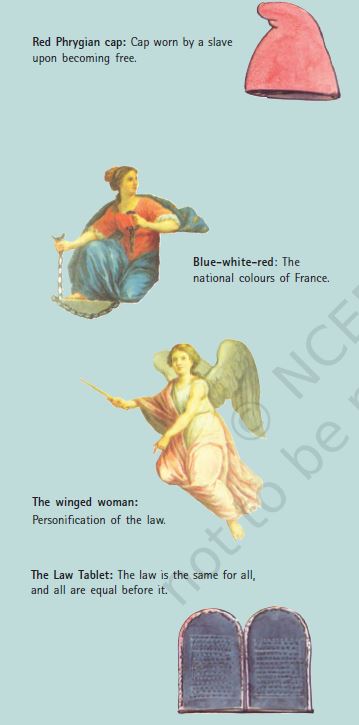
Answer Liberty : The broken chain and the Phrygian cap.
Equality : The winged woman and the Law tablet.
Fraternity : The bundle of rods or fasces and Blue-white-red.
Page 13
Activity 2. Explain the meaning of the painting of the Declaration of Rights of Man and Citizen by reading only the symbols.
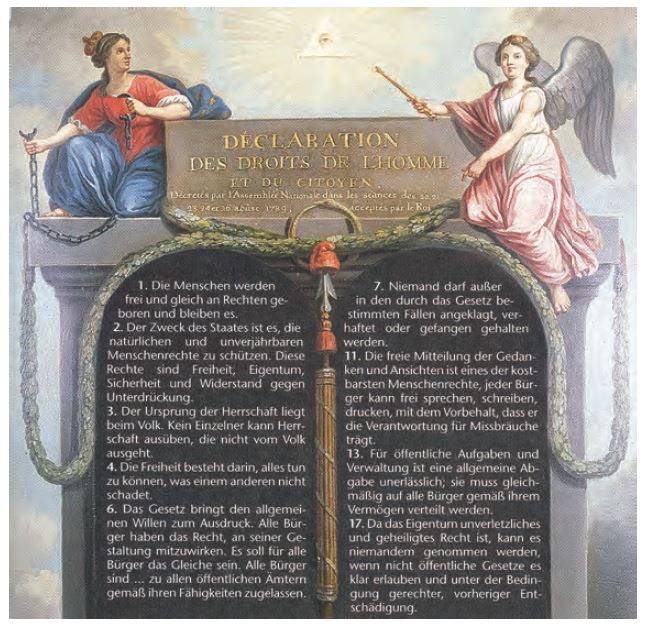
Fig.8 – The Declaration of the Rights of Man and Citizen, painted by the artist Le Barbier in 1790. The figure on the right represents France. The figure on the left symbolises the law.
Answer The figure symbolises the right to liberty, property, equality, etc enshrined in the new Constitution of France. The figure on the right symbolises the law. The law tablet signifies equality before the law for all.
Page 13
Activity 3. Compare the political rights which the Constitution of 1791 gave to the citizens with Articles 1 and 6 of the Declaration (Source C). Are the two documents consistent? Do the two documents convey the same idea?
Source C
The Declaration of Rights of Man and Citizen
1) Men are born and remain free and equal in rights.
2) The aim of every political association is the preservation of the natural and inalienable rights of man; these are liberty, property, security and resistance to oppression.
3) The source of all sovereignty resides in the nation; no group or individual may exercise authority that does not come from the people.
4) Liberty consists of the power to do whatever is not injurious to others.
5) The law has the right to forbid only actions that are injurious to society.
6) Law is the expression of the general will. All citizens have the right to participate in its formation, personally or through their representatives. All citizens are equal before it.
7) No man may be accused, arrested or detained, except in cases determined by the law.
8) Every citizen may speak, write and print freely; he must take responsibility for the abuse of such liberty in cases determined by the law.
9) For the maintenance of the public force and for the expenses of administration a common tax is indispensable; it must be assessed equally on all citizens in proportion to their means.
10) Since property is a sacred and inviolable right, no one may be deprived of it, unless a legally established public necessity requires it. In that case a just compensation must be given in advance.
Answer The two documents are consistent and convey the same idea that human beings are born equal and all citizens are equal before the law. However, the Constitution of 1791 did not give practical shape to these ideas.
Page 13
Activity 4. Which groups of French society would have gained from the Constitution of 1791? Which groups would have had reason to be dissatisfied? What developments does Marat (Source B) anticipate in the future?
Source B
The revolutionary journalist Jean-Paul Marat commented in his newspaper L’Ami du pelople (The friend of the people) on the Constitution drafted by the National Assembly.
The task of representing the people has been given to the rich the lot of the poor and oppressed will never be improved by peaceful means alone. Here we have absolute proof of how wealth influences the law. Yet laws wi II last only as long as the people agree to obey them. And when they have managed yoke of the aristocrats, they will do the same to the other owners of wealth’.
Source : An extract from the newspaper L’Ami du Peuple.
Answer Only some members of the Third Estate, who were rich and propertied, would have gained from this Constitution. Members of the First and Second Estates would have been Dissatisfied as their privileges were abolished and they had to pay taxes.
Marat anticipates another revolution in which the poor will rebel against the rich persons of the Third Estate and overthrow them, just like they had done the noblemen and clergy.
Page 13
Activity 5. Imagine the impact of the events in France on neighbouring countries such as Prussia, Austria-Hungary or Spain, all of which were absolute monarchies. How would the kings, traders, peasants, nobles or members of the clergy here have reacted to the news of what was happening in France?
Answer The kings, nobles, clergy and other privileged sections of these countries would become fearful that what has happened in France can happen in their country also. The peasants would welcome the developments in France and sympathise with the peasants and underprivileged sections of that country.
Page 15 Activity 1. Look carefully at the painting and identify the objects which are political symbols you saw in Box 1 (broken chain, red cap, fasces, Charter of the Declaration of Rights). The pyramid stands for equality, often represented by a triangle. Use the symbols to interpret the painting. Describe your impressions of the female figure of liberty.
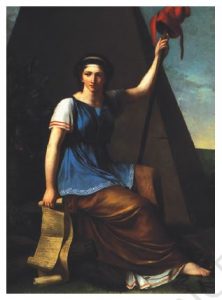
This is one of the rare paintings by a woman artist. The revolutionary events made it possible for women to train with established painters and to exhibit their works in the Salon, which was an exhibition held every two years.
The painting is a female allegory of liberty-that is, the female form symbolises the idea of freedom.
Answer The scroll in the right hand of the woman symbolises the Declaration of Rights of Man and Citizen. The pyramid in the background stands for equality, as all the three sides of a pyramid are equal. The left hand holding aloft the red cap symbolises the torch of freedom. The female figure of liberty symbolises the equality of women and men.
Page 16
Activity 1.Compare the views of Desmoulins and Robespierre. How does each one understand the use of state force? What does Robespierre mean by ‘the war of liberty against tyranny? How does Desmoulins perceive liberty? Refer once more to Source C. What did the constitutional laws on the rights of individuals lay down? Discuss your views on the subject in class.
Source C
The Declaration of Rights of Man and Citizen
1) Men are born and remain free and equal in rights.
2) The aim of every political association is the preservation of the natural and inalienable rights of man; these are liberty, property, security and resistance to oppression.
3) The source of all sovereignty resides in the nation; no group or individual may exercise authority that does not come from the people.
4) Liberty consists of the power to do whatever is not injurious to others.
5) The law has the right to forbid only actions that are injurious to society.
6) Law is the expression of the general will. All citizens have the right to participate in its formation, personally or through their representatives. All citizens are equal before it.
7) No man may be accused, arrested or detained, except in cases determined by the law.
8) Every citizen may speak, write and print freely; he must take responsibility for the abuse of such liberty in cases determined by the law.
9) For the maintenance of the public force and for the expenses of administration a common tax is indispensable; it must be assessed equally on all citizens in proportion to their means.
10) Since property is a sacred and inviolable right, no one may be deprived of it, unless legally established public necessity requires it. In that case a just compensation must be given in advance.
Answer Robespierre felt that use of terror by a democratic government was justified, as it preserved the ideals of the revolution. However, Desmoulins sees liberty as freedom to do anything which is based on principles of equality, reason and justice without being injurious to others. Robespierre saying, ‘the war of liberty against tyranny’ meant that they should kill the enemies of the republic both in France and outside France.
Desmoulins perceives liberty as laid down in the Declaration of Rights, i.e. it is happiness, reason, equality and justice. The constitutional laws on the rights of individuals laid down the rights of liberty, equality, property, security and resistance to oppression.
Page 18
Activity 1. Describe the persons represented in Fig their actions, their postures, the objects they are carrying. Look carefully to see whether all of them come from the same social group. What symbols has the artist included in the image? What do they stand for? Do the actions of the women reflect traditional ideas of how women were expected to behave in public? What do you think: does the artist sympathise with the women’s activities or is he critical of them? Discuss your views in the class.

Fig.12 – Parisian women on their way to Versailles. This print is one of the many pictorial representations of the events of 5 October 1789, when women marched to Versailles
and brought the king back with them to Paris.
Answer They are all women and belong to the same social group, i.e. the underprivileged. The agricultural implements in their hands confirm that they are peasants. The clothes also show their poverty. The symbol of justice held by one woman depicts that they are striving for it. The woman on the horse symbolises power and strength. The drum symbolises that they are proclaiming their march to all concerned.
Here the actions of the women do not reflect the traditional ideas of how women should publicly behave. The artist definitely sympathises with the activities of the women.
Page 20
Activity 1. Compare the manifesto drafted by Olympe de Gouges (Source F) with the Declaration of the Rights of Man and Citizen (Source C).
Source C
The Declaration of Rights of Man and Citizen
1) Men are born and remain free and equal in rights.
2) The aim of every political association is the preservation of the natural and inalienable rights of man; these are liberty, property, security and resistance to oppression.
3) The source of all sovereignty resides in the nation; no group or individual may exercise authority that does not come from the people.
4) Liberty consists of the power to do whatever is not injurious to others.
5) The law has the right to forbid only actions that are injurious to society.
6) Law is the expression of the general will. All citizens have the right to participate in its formation, personally or through their representatives. All citizens are equal before it.
7) No man may be accused, arrested or detained, except in cases determined by the law.
8) Every citizen may speak, write and print freely; he must take responsibility for the abuse of such liberty in cases determined by the law.
9) For the maintenance of the public force and for the expenses of administration a common tax is indispensable; it must be assessed equally on all citizens in proportion to their means.
10) Since property is a sacred and inviolable right, no one may be deprived of it, unless legally established public necessity requires it. In that case a just compensation must be given in advance.
Source F
Some of the Basic Rights Set Forth in Olympe de Gouges’ Declaration
1) Woman is born free and remains equal to man in rights.
2) The goal of all political associations is the preservation of the natural rights of woman and man: These rights are liberty, property, security, and above all resistance to oppression.
3) The source of all sovereignty resides in the nation, which is nothing but the union of woman and man.
4) The law should be the expression of the general will; all female and male citizens should have a say either personally or by their representatives in its formulation; it should be the same for all. All female and male citizens are equally entitled to all honours and public employment according to their abilities and without any other distinction than that of their talents.
5) No woman is an exception; she is accused, arrested, and detained in cases determined by law. Women, like men, obey this rigorous law.
Answer The manifesto drafted by Olympe de Gouges mentions women and equality throughout its text, mentioning women first in all places. The Declaration of the Rights of Man and Citizen does not mention women at all, it only talks about men.
Page 20
Activity 2. Imagine yourself to be one of the women in Fig. Formulate a response to the arguments put forward by Chaumette (Source G).
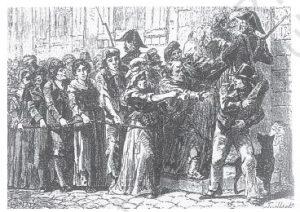
Fig.13 – Women queuing up at a bakery.
| Source G In 1793, the Jacobin politician Chaumette sought to justify the closure of women’s clubs on the following grounds: Has Nature entrusted domestic duties to men? Has she given us breasts to nurture babies? No. She said to Man: She said to Woman: Shameless are those women, who wish to become men. Have not duties been fairly distributed? |
Answer The arguments given by Chaumette are not justifiable. He has mentioned only the biological role of women. As individuals, women have equal rights to men and so they must be treated equal to men. They would, of course, continue their traditional roles like bearing and nurturing children, feeding them, etc, but women are equally capable as men to carry out the other duties of human beings also.
Page 21
Activity 1.Record your impressions of this print. Describe the objects lying on the ground. What do they symbolise?What attitude does the picture express towards non-European slaves?
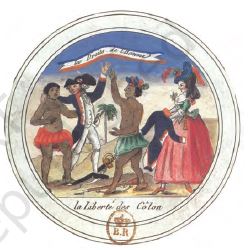
Fig. 14 The Emancipation of Slaves. This print of 1794 describes the emancipation of slaves. The tricolour banner on top carries the slogan: The rights of man’. The inscription below reads: “The freedom of the unfree’. A French woman prepares to ‘civilise’. the African and American Indian slaves by giving them European clothes to wear.
Answer This print symbolises the superior feeling of French people towards slaves from Africa and the Caribbean. The French thought that these people were uncivilized. The slogans represent the fact that the former slaves will have equal rights to the European settlers, now that the slaves are free.
The objects lying on the ground are European clothes, symbolising the superior culture of Europe compared to that of the slaves. This expresses the racial and condescending attitude of the French towards the slaves.
Page 22
Activity 1. Describe the picture in your own words. What are the images that the artist has used to communicate the following ideas: greed, equality, justice, takeover by the state of the assets of the Church.
Answer Greed is symbolised by the fat clergyman on the left. The two men accompanying him symbolise government officials who have taken over the assets of the Church. The fat reducing press in the middle symbolises justice. The man and woman on the right symbolise equality. The whole picture depicts what the revolution stood for.